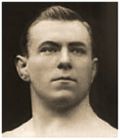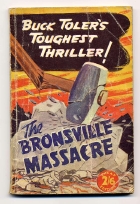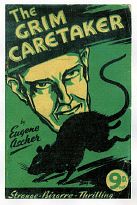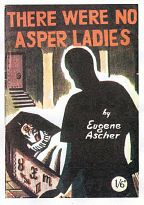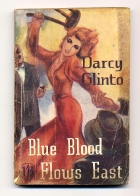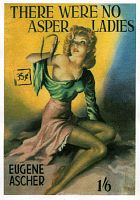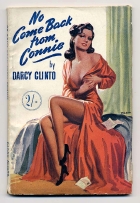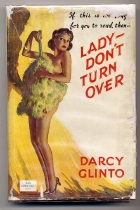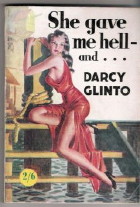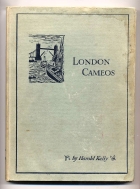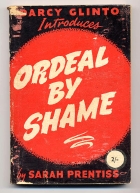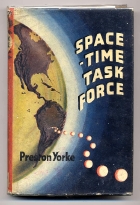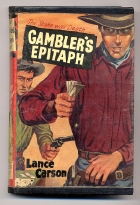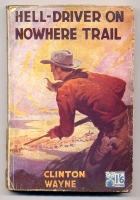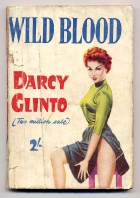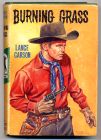Found Pages: The Remarkable Harold Ernest (“Darcy Glinto”) Kelly, 1899–1969.
BioBibliographical
Akira Kurosawa
Caving website
Prefatory:
I’ve aimed here at a complete chronological listing of works attributed or attributable, with varying degrees of certitude, to Harold Ernest Kelly in his manifestations as a writer of crime fiction, supernatural fiction, science fiction, Westerns, and miscellaneous.
But there will inevitably be errors of omission and commission.
I hope they’ll be brought to my attention. One of the pleasures of the Web is that nothing’s irrevocable, at least within the limits of a webmaster’s patience.
I’ve been able to access some fifty of the works listed here. There are still almost thirty others that I haven’t seen.
I’ve used boldface for the first appearance of a work and for a few significant reprints or reissues. I’ve included publishers’ information that I found in the Kelly books.
I’ve indicated, mostly with initials, where I found a book assigned to a particular year and in what library or group of libraries it may be available.
I’ve also provided what little personal information about Kelly has come my way, and mentioned some relevant events in the publishing industry.
There are links and references to the Notes page and to what I have called Sidebars, since they are parts of the ongoing presentation and not simply appendices. Several of them are mini-articles. A number of the notes are substantial.
In the also chronological “Danger, Inc.,” I provide fuller descriptions of the contents of the books that I’ve been able to access. There are some links between the two chronologies, and links to individual Notes and Sidebars.
“Danger, Inc.” also contains the titles of lots of other violence-related works, both fiction and non-fiction, that appeared during Kelly’s lifetime, with descriptions.
Readers who aren’t particularly interested in bibliographical details may prefer to go straight to “Violence, Inc.”
Apart from City Mid-Week in 1931-32, Kelly himself doesn’t enter the scene as a writer until Part 3 (1940–45) of “Violence Inc.”
But the material in Parts 1 and 2 (1899–1928, 1929–39) may not all be familiar to the point of boredom.
There are fuller descriptions of a number of Kelly’s books, and descriptions of books by other authors, in the five-part “Violence, Inc.”
Pseudonyms (with attributions):
Eugene ASCHER, (4 books); AJH, NGC, ESF
Lance CARSON (14), THJ, NGC, BLIC, LC
Darcy GLINTO (19), AJH, NGC, BLIC, LC
Gordon HOLT (1), AJH, BSF, BLIC, LC
Hank JANSON (13), ESF, RW/SH, THJ
In The Trials of Hank Janson (2004), Steve Holland’s attributions to Kelly are absolute. In the Janson bibliography that he and Richard Williams did in 2001, the attributions are almost all tentative, as are several of Allen Hubin’s. Steve tells me that the omission of the question marks was accidental.
Chuck LARSEN, THJ
Duke LINTON (1), JF
Bryn LOGAN (4), JF
Wenda MALLESON (?), SHp
John PARSONS (2), NYP, LC
Buck TOLER (4), AJH, NGC, ECB, BLIC, LC
Clinton WAYNE (6), BSF, THJ
Preston YORKE (5), NGC, BSF, ESF
There is also a Harold C. Kelly out there who published on horology and a Harold Kelly who was the Art Editor of a Fawcett How To book on photography.
Sources
AJH—Allen J. Hubin, Crime Fiction II; a Comprehensive Bibliography, 1749-1990, rev. ed. 1994
BCNC—Steve Holland, “A British Crime Noir Chronology 1927-47”
BLIC—British Library Integrated Catalogue (online)
BM—British Museum General Catalogue of Printed Books to 1955, 1962
BM68—British Museum General Catalogue, Ten-Year Supplement,1956-1965, 1968
BM72—British Museum General Catalogue, Five-Year Supplement 1966-1970, 1972
BSF—Philip Harbottle and Stephen Holland, British Science Fiction Paperbacks and Magazines, 1949-1956, rev. ed.
Copac Consolidated online British university and national research libraries.
ECB—English Catalogue of Books issued in Great Britain and Ireland (series)
ESF—Encyclopedia of Science Fiction (Steve Holland)
HK/LC—Harold Kelly, London Cameos (1951).
JF—John Fraser.
LC—Library of Congress print catalogue.
LCOC—Library of Congress Online Catalog.
LH—Lee Horsley. The Noir Thriller (2001)
MF—Maurice Flanagan, British Gangster and Exploitation Paperbacks of the Postwar Years (1997)
MJ—Steve Holland, The Mushroom Jungle; a history of postwar paperback publishing (1993)
MWp—Morgan Wallace, personal communication.
NCB—Darcy Glinto, No Come Back from Connie, back cover.
NGC—New General Catalog of Old Books and Authors www.kingkong.demon.co.uk/ngcoba/ke.htm
NUC—Library of Congress—National Union Catalogue (print)
NYP—New York Public Library online (CATNYP).
PC—“Publishers committed for trial on pornography charge,” Bookseller, April 23, 1942, front page.
PPP—Paperbacks & Pulps & Pamphlets Page/ Want List
RW/SH—Richard Williams and Stephen Holland, Hank Janson Books: a Checklist (2001)
SH/BGE—Steve Holland, introduction to Maurice Flanagan’s British Gangster and Exploitation Paperbacks
SHp—Steve Holland, personal communication.
SFE—SF Encyclopedia Updates www.dcs.gla.ac.uk/SF-Archives/Misc/sfec_i2l.html
THJ—Steve Holland, The Trials of Hank Janson, (2004),
Publishers:
AEP—Art and Educational Publishers
Cs—Collins
C—Compact
E—Everybody’s Books
FM—F. Muller
FJ—Francis James
GT—George Turton
HK—Hector Kelly
LM—L. Miller
MI—Mitre
Mo—Alexander Moring
R—Racecourse Press
Ro—Roberts and Vintner
RH—Robin Hood
SC—Scion
SP—Sylvan Press
WL—Ward, Lock
WGD—Wells Gardner, Darton
Number of original books per year attributed or attributable to Kelly with varying degrees of certitude,
1940 (1), 1941 (5), 1942 (0), 1943 (4), 1944 (5), 1945 (1), 1946 (1) 1947 (5) 1948 (8), 1949 ( 8), 1950 (4 or 5), 1951 (4), 1952 (3 or 4), 1953 (3), 1954 (1), 1955 (0), 1956 (2), 1957 (1?), 1958 (1), 1959 (0), 1960 (1), 1961 (3?), 1962 (5?), 1963 (3?), 1964 (3?), 1965 (0).
Total: about 72, which is almost certainly too high, given the uncertainties about a number of titles, especially among the Westerns and the Jansons.
Sidebars:
- Sidebar 1. Some Orchids
- Sidebar 2. Chase and Glinto
- Sidebar 3. The Pre-trial Glintos
- Sidebar 4. Deep South Slavery
- Sidebar 5. Darcy Janson
- Sidebar 6. Rogues’ Gallery
- Sidebar 7. Kelly Brothers
- Sidebar 8. Scandal
- Sidebar 9. Westerns
- Sidebar 10. City Mid-Week
- Sidebar 11. Gangdom
- Sidebar 12. Jungle Books
- Sidebar 13. Bodily Harms
- Sidebar 14. Belgium 1914
Chronology
There is additional information, some of it substantial, in the Notes and Sidebars. I haven’t always remembered to refer readers to particular items there.
All novels are set in the States unless otherwise indicated.
1899
Harold Ernest Kelly is born.
1911
Brother Hector John Oliver Kelly is born and outlives Harold by a number of years. To judge from their collaborative publishing ventures, the brothers were very close. For their birthplaces and parents, see Note 2 and Note 55.
1931
In December, Harold Kelly (a free-lance journalist) and an unnamed journalist with Reuters (John Ramage Jarvie?) start the weekly newspaper City Mid-Week, intended, as Harold recalls twenty years later in London Cameos, to
stagger Fleet Street by its ‘scoops’ and the high literary level of its features and comment, and to shake the whole City [ of London ] to its foundations by digging out its most cherished and esoteric secrets to the light of print. HK/LC
Harold publishes affectionate weekly character sketches in it of predominantly “little” City of London types like a postman, a bell-ringer, a beadle, a pier-master, collected in 1952 as London Cameos.
His associate, as managing-editor, may have been John Ramage Jarvie.
For more about City Mid-Week, see Sidebar 10.. For the sketches, see London Cameos (1951).
1932
In October City Mid-Week goes out of business as the result of a libel suit by “one of the world’s greatest financial corporations” in which the plaintiffs are awarded damages of fifty-thousand pounds (a huge sum back then, see Note 8) at the Old Bailey. After which, “one founder returned to an old association with Reuter’s and the other [Harold] to his free-lancing.” HK/LC
However, the damages were apparently against the publishers, not the editors. For this and other aspects of the case, see Steve Holland’s comments in Supplementary, City Mid-Week libel case.
1933
Harold Kelly, What the Doctor Thought [?] NEW
Play performed by The Shop Window in the Grafton Theatre, London, Jan. 30, 1933.
For more, see Note 59.
1936
In a book review George Orwell quotes a violent passage from Paul Cain’s Fast One and comments,
This kind of disgusting rubbish, hailed as ‘genius’ when it comes in a slightly more refined form from Hemingway is growing commoner and commoner. Some of the threepenny “Yank Mags” which you buy at Woolworth’s now consist of nothing else.
New English Weekly, Apr. 23.
So far as I can tell, he would not have had British novelists in mind at that point. Peter Cheyney’s This Man is Dangerous did not appear until September, and the most “American” of Edgar Wallace’s gangster novels, the excellent On the Spot (1931), was much more psychological.
See Sidebar 6
1937
Harold edits five short self-published books by the remarkable champion wrestler, body-builder, and health proselytizer George Hackenschmidt (1878-1968), who had been appearing in print for a number of years.
Attitudes and Their Relation to Human Manifestations, Copac
Consciousness and Character; True definitions of entity, individuality, personality, nonentity, Copac
Self-Improvement, Copac
The Three Memories and Forgetfulness; What they are and what their true significance is in human life, Copac
Fitness and Your Self, Copac
I have photocopies of a few pages from the beginning and end of Fitness and Yourself. On the title page, under the author’s name, we have “Edited by Harold Kelly,” and at the foot of the page, “Enquiries for literature and personal interviews George Hackenschmidt, 1, Lower James Street, Regent Street, London W.1” The handwritten and stamped library dates are 1938.
For more about Hackenschmidt, see Note 19
1939
René Brabazon Raymond’s first novel, No Orchids for Miss Blandish, is published by the well-established firm of Jarrolds as a 255-pp. hardcover over the name of James Hadley Chase. In a Postscript we learn that, “The Publishers, Printers, and Readers of No Orchids for Miss Blandish are still convalescing from shock. They thought they could take it until they ran into Slim Grisson.…” The term “Readers" obviously refers to the appraisers of submitted manuscripts.
For more about this ground-breaking work, see Sidebar 1 and Sidebar 2.
1940
The warehouses of twenty-seven publishers around St. Paul’s Cathedral are destroyed during the Blitz. Millions of books and acres of stock go up in flames. Publishers and newspapers are assigned paper quotas.
Darcy Glinto, Lady—Don't Turn Over, Wells Gardner, pb, 192 pp. (December, EC), AJH, BLIC; reissued, with cuts, in 1952 by Robin Hood, hc,
The daughter of a top FBI official is snatched by a white-slavery and blackmail gang.
On the cover of the first edition (second impression), an apprehensive-looking blonde is sitting on the edge of a bed in a green slip (the shoulder straps down) and a transparent green negligee.This may not be the same cover as for the first impression. See Note 3.
No more of Glinto’s books are listed in the book-trade English Catalogue for the next seven or eight years
For more, see Sidebar 2, Sidebar 3, Sidebar 8.
1941
Darcy Glinto, No Mortgage on a Coffin, Wells Gardner, pb, 155 pp., reissued Robin Hood, 1953, AJH, BLIC
An East Coast gang boss involved with American Nazis has problems with three women.
Orange pb covers, with “Darcy Glinto’s No Mortgage on a Coffin One Shilling Net” in black letters on the front.
Title page sans serif. Publication date January 1941.
There is also a dust-jacket, with on the front a crisp arrangement of the title at the top in jiggly characters, the author’s name sans-serif in the opposite corner, and in between a well-shaped reclining blond in a short red dress gazing unperturbed at a smoking automatic on the implied floor.
On the back, in addition to Lady and No Mortgage, are listed: Horace McCoy’s, They Shoot Horses, Don’t They?, Robert C. Du Soe’s The Devil Thumbs a Ride, Emory Bonett’s A Girl Must Live, and Stuart Palmer’s The Ace of Jades.
See Sidebar 3
Darcy Glinto, “Snow” Vogue, Wells Gardner, pb, 160pp. BLIC, Copac
A hoodlum rises in the drug racket.
Same general configuration as for No Mortgage, but pb covers off-white. On the dust-jacket a pensive-looking brunette is sitting erect, supported by her hands behind her, on a pale-blue ground, in a high-style one-piece, soft-fabric white lounging suit (?) with loose-cut sleeves and pants-legs, and a hood.
On the back, in addition to Lady, No Mortgage, Snow Vogue, the same Du Soe, Bonnet, and Palmer titles, are Don Tracy’s sardonic lynching novel How Sleeps the Beast, Harvey Klemmer’s Harbour Nights, Lady Mary Cameron’s Mr. Dayton, Darling, and Lillian Day’s Kiss and Tell.
See Sidebar 3
[“Carl” has reported, fascinatingly, having a hardcover copy, and has provided the following bibliographical note
First edition. 8vo., endpaper, [8pp.], pp-9-160, in the original saffron cloth, gilt titles on spine, illustrated white paper dustwrapper printed in grey-blue, black and reds, publishers’ blurb on front fold in and lower portion (with adverts for forthcoming titles). London, Wells Gardner Darton & Co., Ltd., Athenaeum Printing Works, (1941).
The wrappers depict a ‘chic’ but rather louche woman, called Zola, in a white hooded lounge suit, matching heels, red lipstick, heavily made up eyes and exceptionally long lashes. She sits despondently upon the floor; as well she might for “Dario” beats her severely with a cane by page twenty six.
There’s no literal identification of the cover girl, but she could indeed be Zola.
He has also scanned the cover to me. The front image is the same as for the pb. On the back we have:
Darcy Glinto’s Latest
“I pull the fastest gun west of Sandy Hook. I work on a rake-off for the guys that run the morgue.”
This is Darcy’s description of himself and here in Snow Vogue is the story of Dario—cold-blooded and ruthless gangster.
It is just as slick and twice as fast as any other gangster story. That is because Dario is that kind of man.
- By the same Author—
- Lady—Don’t Turn Over
- No Mortgage on a Coffin.
- Ready shortly
- Road Floozie
- We All Gotta Start, Sister
- You Took Me—Keep Me.
“We All Gotta Start, Sister” is presumably the working title of Yours Truly, Hoodlum, the cover of which is reproduced in colour on the back of Maurice Flanagan’s British Gangster and Exploitation Paperbacks of the Postwar Years (1997)
The fact that Snow Vogue appeared in hardcover makes me wonder about the other five first-series Glintos.
Darcy Glinto, You Took Me—Keep Me, Wells Gardner. AJH, BLIC; reissued in 1950 by Robin Hood
A raped girl becomes the partner of her young hoodlum assailant.
Same off-white pb. covers as Snow Vogue’s.
Back covers bears the words:
Here is Darcy Glinto at his best with a new terrific story of the American gangster world.
In this book there is no false sentimentality: the gangster is painted for what he is—cruel and vicious, courageous perhaps, but with the courage of an animal. In short, a killer, whose kind is doomed from its inception.
And yet it is this very nature which attracts its feminine opposite. Darcy Glinto here unfolds the story of the girl who, having once cast in her lot with the gangster is content to emulate and to follow, her only justification lying inher own words: “You took me—keep me!”
See Sidebar 3
Darcy Glinto, Yours Truly—Hoodlum, 159 pp, Wells Gardner; reissued in 1953 by Robin Hood, AJH.
A young tough’s fascination with the underwear he sees on a gunman’s dead floozie after a car-crash causes problems during his brief criminal career.
In the 1941 edition of Road Floozie, it is the last of the thirteen books listed as “Titles in this series.” So it appeared in that year, before Road Floozie.
The cover of the Robin Hood reissue, showing a foreground redhead in an hour-glass-shaped bright red dress recoiling from a burly middle-aged guy in tuxedo and black bow tie has nothing to do with the contents of the book.
Darcy Glinto, Road Floozie, Wells Gardner, pb BLIC Copac; reissued in 1950 by Robin Hood, hb and pb,, and in 1953, hc
A freedom-seeking working girl takes to the perilous road.
A skinny/svelte blonde in a pale olive-green dress and strap heels, with a mysterious dark triangle in the pubic area, occupies the right side of the front cover, her right hand holding—what? a lighter with flame? a tiny automatic? On the left side is Road Floozie in black script slanting upwards, with “Darcy Glinto” further down. Price one shilling net.
On the back cover are “Titles in This Series.” In addition to Lady—Don’t Turn Over, No Mortgage on a Coffin, Snow Vogue, Road Floozie, and Yours Truly—Hoodlum, we have:
Robert C. Du Soe, The Devil Thumbs a Ride
Emery Bonett, A Girl Must Live
Stuart Palmer, The Ace of Spades
Don Tracy, How Sleeps the Beast
Harvey Klemmer, Harbour Nights
Lady Mary Cameron, Mr. Dayton, Darling
Lillian Day, Kiss and Tell
Maurice Dekobra, The Street of the Painted Lips.
The inside blurb is:
There was a girl who worked in a dress factory.
The working conditions were not uncommon—they could be summed up in one word—“sweated.”
She left!
The Road called her—fresh air, sunshine and freedom—above all, Freedom.
Here, then, is the story of her life on the Road, her beginning and her end, a warning which should also become a promise that such things must not be allowed to endure.
Too many Eilleens in this world, victims of sweated labour, escape only to become victims of still more terrifying conditions.
See Sidebar 3.
1942
In a trial at the Old Bailey on May 19th, Pilot Officer (Admin.) René Raymond (James Hadley Chase) and his publishers, Jarrolds, are heavily fined for Miss Callaghan Comes to Grief, and Harold Ernest Kelly (Glinto) and Wells Gardner, Darton, his publishers, are heavily fined for Lady—Don’t Turn Over and Road Floozie. The books have to be withdrawn from circulation.
In the words of a News Chronicle report, Kelly is “ordered to remain in custody until the money [ is ] paid.” To judge from an online computation system, a hundred pounds back then, which is what he had been fined, would probably have been the equivalent of at least five thousand dollars now. See Note 8.
At the time he was living in a village five miles from Romford, which was about fifteen miles north-east-east from central London and a major black-market center.
See Sidebar 3, Sidebar 8, Sidebar 11
Preston Yorke, “Strictly to Plan”, in Tales of Terror and Surprise, BSF
According to BSF, the pseudonym was created by brother Hector, “who also published a later SF novel as Yorke.” (p. 90)
1943
Hector and Harold co-found Everybody’s Books, with Hector as managing director. See Sidebar 7.
Buck Toler, The Bronsville Massacre, Mitre, (June EC), AJH, BLIC,
An East Coast gang moves in on industrial companies and their labour union in Indiana.
On the front cover, with at the top the charmingly bravura claim, white on black, “Buck Toler’s Toughest Thriller” (at that point it was his only one), we have a huge rock with dead men around the bottom and a massive hammer in the process of breaking on it. Price 2/6d—not cheap.
The back is occupied by an ad for The Crown Colonies and Their History by Cumberland Clark.
According to the blurb,
This is Tough. This tremendous thriller issued for the first time in Great Britain possesses a breath-taking fury and intensity rarely found in books published on this side of the water
The story of a gangster who discovered and exploited a new and gigantic kind of racket, is written in streamlines, sizzling Americanism, as a glance at the opening or any other page will show.
From the first line Buck Toler greets you with a furious fascination, compelling you to read on and on. We do not propose to tell you the plot here, but it is plenty tough, and not for those who prefer milk and water to strong drink.
In the back are five pages of ads for other Mitre books, a product called Crystal Window Washer, The Geneological Quarterly, and a Mitre Press annual The Spring Anthology seeking poems. The inside back cover carries an Everybody’s Books offer to buy unwanted books and ’zines. I see that among the ’zines are Lilliput, Men Only, Life, Saturday Evening Post, and Look.
Recently published Mitre books include Connoisseurs of the World, The Function of the Orgasm (Wilhelm Reich), Lessons in Personality Development for Boys and Girls, What You Don’t Know about George Washington, Golden Book of Great Poetry, novels by Mary Hochstadter, Natalie G. Johnson, and Mary Beard, and a series of Athletic Books, including How to Develop a Powerful Chest, Muscular Manhood: Pictorial Studies of the Athletic Man (illustrated by 31 full-page plates), and Sex—and the Athlete.
See also Violence 3.
Preston Yorke, The Astounding Crime, with two tales by Michael Hervey, Everybody’s Books, 65pp; reissued in 1945 as Death on Priority 1, Everybody’s, BM
Steve Holland reports that the pseudonym was invented by Hector, “who also published a later SF novel as Yorke.” (HH p. 92)
Preston Yorke, The Gamma Ray Murders, Everybody’s, 128pp., 16 chapters, cover art Jeff Cook, 2/- BLIC
“A scientist is murdered and the plans for his secret ‘Gamma Ray’ are stolen and turned on London, Detective Inspector Bevis is on the trail after the villains, and with the aid of a girl--Aline--they jointly thwart the devilish plans of the Master Menace, known as ‘X.’” (Morgan Wallace)
Preston Yorke, The Case of the Strangled Seven, etc, Everybody’s, 128pp. BLIC
Allen Hubin dates it 1944. For the plot, see Morgan Wallace’s description in Note 65.
Harold Kelly, “Confession by Jury,” pp. 5-9, in Tales of Mystery and Surprise, along with tales by Richard Westlake, Arthur Armstrong, Sydney Denham, Kent Barnett, and Sidney [sic] Denham, Everybody’s Books, 32 pp., 6 1/2 x 4” JF
A short-short story about the deliberations of a jury in a murder trial.
None of the wares of Everbody’s Books are advertised in this tiny undated booklet. Instead—this in paper-saving wartime!—the contents are listed twice. Presumably there aren’t yet any other Everybody’s books at this point. The ad is identical with the one in The Bronsville Massacre. 1943 seems a likely date. See Sidebar 7
1944
Buck Toler, It's Only Saps That Die, Everybody’s (Feb EC), AJH, BLIC
Dramatic front cover, announcing “Buck Toler at his toughest and roughest,” and showing a blonde trapped and bleeding as she’s crushed between the teeth of two gigantic blood-spattered cog-wheels as a hatless man leans desperately towards her. Apart from the blood, and the yellow of the main title, and the price, the colour is shades of brown-grey.
Inside is a full-page ad by Everybody’s Books (Charing Cross Road) offering to buy used books.
To judge from a photocopy of the first three pages, the book is about the homicidal boss of a massive Black-Market trucking operation, based in Chicago.
Buck Toler, The Bronsville Massacre, Everybody’s (reissue), BLIC
Eugene Ascher, There Were No Asper Ladies; a New and Strange Kind of Thriller, Mitre (Everybody’s), cover Jeff Cook ( Feb.), ECB; reissued by Robin Hood Press in 1946 with sinister silhouetted figure in foreground; reissued in June 1947 (copyright 1946), Robin Hood, ECB, BLIC; also in 1959 (World), and 1965 (Consul, same plates), as To Kill a Corpse, 159 pp.
An investigator of the supernatural protects an aristocratic friend from her sinister and very long-lived neighbour.
“1944 edition had a blue and red cover, guy with flashlight pointed at a coffin with a vampire in it.” (MW)
Eugene Ascher, The Grim Caretaker, Strother’s Bookshops, 50pp, 9d
10cm x 15.5cm. Digest pamphlet, not saddle-stapled. First 18 pp on pink paper, rest normal tan-tone pp. Black and green cover art by Doug(las)(las)
[Information from Morgan Wallace, to whom thanks also for the covers of The Grim Caretaker and No Asper Ladies, and for the substantial synopsis of the plot of The Grim Caretaker in Note 60.]
Also published by Everybody’s? (AJH)
Eugene Ascher, Uncanny Adventure; 5 Strange Thrillers, 48 pp, Everybody’s, AJH, BLIC.
“The Lady in Suite 7,” “The Man Who Howled,” “Moon of Evil,” “Murder from Far Away,” ”Tagriff’s Cats”
Preston Yorke, The Case of the Swinging Spider, Everybody’s, BM
Printed on old orange thick construction paper stock. Two- colour cover: Orange and Blues only. Large spider in blue before a Mexican-looking pyramid structure. Illustrator looks like J. Mace. (Morgan Wallace)
“A deadly legacy of evil from the past plagues the present. Many lives are lost as this deadly secret is discovered hidden away by guardian temple priests. A young girl will die unless the ingenuity of Scotland Yard's modern cunning can match wits against an arcane evil from the dim reaches of the past….” (MW)
Preston Yorke, “The Common Cold Murder” In James Atholl, The Swastike Murder, Everybody’s Books, 6d.
About 6 inches tall by 4 inches wide. White covers with red and black illustrations on the paper stock. Atholl’s story runs 27 pp, Yorke’s begins on p. 28 and finishes on p. 34. Total page count 34. (Information provided by Morgan Wallace.)
For a plot summary, see “The Common Cold Murder” in Supplementary.
Preston Yorke, “Strictly to Plan,” in Anon., ed., Tales of Terror and the Unknown, 96pp., pb., 2.-
Michael Hervey and Harold Kelly, She Loves Me, Mitre, 32pp. EC
1945
Preston Yorke, Death on Priority 1, Mitre; reissue of 1943 The Astounding Crime,
John Parsons, Give the People Homes; It Lies with You! Francis James, for the Liberal Party, 32 pp., drawing of houses on front cover. LCOC NYP.
Attributed to Kelly in the printed Library of Congress catalogue and the online catalogue of the New York Public Library. A thirty-two page pamphlet, evidently done for the Liberal Party with the coming post-war election in mind, about the urgent need for an intelligent provision of good housing after all the losses and accumulated backlog during the War.
See Note 20 for more.
There are five Kelly originals in 1947 and eight in 1948. It seems likely that if he and Hector were looking ahead to the founding of Robin Hood Press, Harold was at work during the two lean years of 1945 and 1946 on books to start things off.
1946
Buck Toler, Killer on the Run, Everybody’s, AJH
A black car with one of its two rear windows shot or knocked out barrels along a highway under a lurid orange-red sky and smashes through a wooden barrier. Price 1/6d.
Inside, Everybody’s Books offers to pay well for used books and zines.
Very small print and narrow margins.
“Here is the epic of that greatest of all thrills, the man hunt! The gangster, the killer, the rat without a conscience has been driven into the open.… With him, sharing the terrors, the doublings and twistings of the panic-stricken run, is a beautiful girl. A strange enigmatic personality…
(Blurb)Eugene Ascher, There Were No Asper Ladies, Robin Hood; reprint of 1944 Mitre ed., AJH, BLIC
1947
Hector and Harold embark on their main publishing venture, Robin Hood Press, with Harold as its “mainstay author” (Steve Holland). Darcy Glinto re-emerges. According to Steve, the Press was founded in 1946 and There Were No Asper Ladies in 1947 was their first publication.(SHp)
Writing in 1983, Hector recalls that: “The bulk of the material was published in paperback, but after a year or so, I conceived the idea of binding some of these up for the libraries, and this was quite successful.”(Private letter, quoted by Steve Holland in THJ)
Several of the Robin Hood books, both paperback and hard-back, have most of the front cover or the front of the dust-jacket occupied by a large red circle, truncated at left and right, with the title in it in semi-calligraphic white, the remainer of the cover, top and bottom, being black with the author’s name on it in red.
For more, see Sidebar 7.
Darcy Glinto, Curtains for Carrie, Robin Hood, AJH, BLIC LCOC; reissued in 1953 by Robin Hood, hc
A girl carries on her executed father’s rum-running operation and goes after the rival who framed him.
The first Glinto in six years.
The misleading Imre Hofbauer cover (black-and-white in Flanagan, p.13) has two dames with big hair in evening gowns facing one another, one seen from the back.
For more, see Violence 4.
Darcy Glinto, Blue Blood Flows East, Robin Hood, pb , AJH, BLIC; reissued in 1956 as Wild Blood, Moring.
A high-spirited socialite becomes involved with a young gang boss and his very dangerous rival.
I’m puzzled by the claim by Steve Holland and Allen Hubin that this also appeared in 1950, in a Stephen Frances operation, as Crazy to Kill by Duke Linton. Were readers’ memories really so short?
On the front cover, a redhead in a long red dress is menacing a hat-and-shoulders foreground figure with a raised three-legged stool. A man behind her is pointing a gun at her.
The back cover lists There Were No Asper Ladies, Curtains for Carrie, Cattle Cache at Desert Pan, and Tough on the Wops, without authors’ names.
The page facing the start of the narrative bears the words “To Kathleen,” one of only three dedications that I can recall anywhere in what I have seen of Kelly’s oeuvre. I’d like to think she was his wife or fiancée. But she may have been his sister. See Note 55
Buck Toler, Tough On The Wops, Robin Hood, AJH, BLIC, LCOC
An Italian-American girl sets out to avenge the murder of her restaurant-owner fiancée by a gang.
Back cover advertises There Were No Asper Ladies, Cattle Cache at Desert Pan, Curtains for Carrie, and the forthcoming Blue Blood Flows East
For more see Note 23.
Eugene Ascher, There Were No Asper Ladies , Robin Hood, reprint, SHp
Cover by Reginald Heade, showing sexy, big-haired blonde in falling-down green blouse and great smoky stockings (in 1947 austerity Britain yer) sitting on indeterminate surface, price 1/6. Steve Holland says in a personal letter that this was the first Robin Hood title. The picture has nothing whatever to do with the contents.
According to Steve’s The Trials of Hank Janson, especially pp 74–75 and 228–229, Heade (Reginald Cyril /Webb, 1901–1957), being exempt from conscription because of bad eyesight, had done covers during the War “on everything from Barbara Cartland romances and Zane Gr Grey Westerns to W.E. Johns; stories of juvenile adventures ‘Worrals’.”
In the Forties and early Fifties, Heade did covers for, among others, books by Earl Stanley Gardner, Hank Janson (lots), Spike Morelli, Paul Renin, Gene Ross, Michael Storme, and Roland Vane. Steve shrewdly notes that his Hank Janson women “looked askew at some threat just out of sight of the reader, shocked at a sudden intrusion or fearful of some continuing torment.
They must have sold lots of books. Did the Kellys unleash his eroticism?
Lance Carson, Cattle Cache at Desert Pan, Robin Hood, 168pp. BLIC, LCOC
Kelly’s first Western.
Lance Carson,“Stampede!” pp. 3-12 in Boys’ Adventure Library ll; A further selection of exciting short stories for boys Art and Educational, pb, pocket-size, pp 3-12.
An old ranch-hand recalls a buffalo stampede.
1948
Darcy Glinto, No Come Back From Connie, Robin Hood pb, ALH, BLIC
The woman boss of a gang resists the attempts of the well-born boss of a rival gang to dominate her.
Semi-glossy paper, with small print and narrow margins, paper rationing still being in effect. A woman with good hair sits on a bed in a flowing red peignoir, with her legs and the tops of her breasts exposed. The same image is used for Mannequin Moll in the same year.
On the back cover we have ads for the following Robin Hood Glinto titles:
No Come Back from Connie (“Red haired and of Irish Blood, Connie was a fighter”),
Dame Between Two (“Glinto’s latest on rackets and payoffs”),
Mannequin Moll (“How dames run rival gangs”),
Snow Vogue (“Fiendish drug orgies shock America”),
Straight Up Girl (“The book from Chicago that New York banned.”)
For more see Violence 4.
Darcy Glinto, Dainty Was a Jane, Robin Hood, AJH, BLIC, reprinted in 1956 as Blonde, Cute and Wicked, Moring, AJH. NEW
New York gang member Dainty Sabina, a young woman successfully passing as a man, takes an interest in a gifted but show-offy new gang member with a yellow streak, and tries to stiffen his spine with a view to the two of them eventually becoming gang bosses.
The front cover by Terry, which has nothing to do with the contents, shows a sexy and sophisticated-looking woman sitting on what may be a divan, with her negligee spread out so as to expose the tops of her breasts above a black tight-waisted foundation garment, and below it a couple of inches of thigh above lacy stocking tops. Title top right, author’s name and price (2/-) bottom left.
On the back is a list of Robin Hood Press books now on sale, all by Kelly—There Were No Asper Ladies (Eugene Ascher), Curtains for Carrie (Glinto), Cattle Cache at Desert Pass (Lance Carson), Tough on the Wops (Buck Toler), and Blue Blood Flows East (Glinto). At the bottom we’re told that “More full booklength stories by these and other popular authors will be published shortly.”
On the inside back cover, we learn that Darcy Glinto has written Lady—Don’t Turn Over, No Mortgage on a Coffin, Road Floozie, Snow Vogue, You Took Me, Keep Me, Curtains for Carrie, Blue Blood Flows East, and Yours Truly, Hoodlum.
On the final page of text (I’m not replicating the layout, we have,
If you enjoyed this book, read No Comeback from Connie, the next in the present series by Darcy Glinto. One of his finest stories. This is being printed and will be on sale shortly, Price 2/-
The inside front cover is taken up by a blurb that makes the book sound far more interesting than it is. E.g., “Darcy Glinto never falls short in movement, excitement, interest. Yet in ‘Dainty Was a Jane,” he has added something else. A romance of the gangs.”
For more about how it actually reads, see Violence 4.
Darcy Glinto, Dame Between Two, Robin Hood, AJH, BLIC
“Glinto’s latest on rackets and payoffs.” NCB
Darcy Glinto, Mannequin Moll, Robin Hood, NCB.
“How dames run rival gangs.” NCB
Mistitled by AJH, as The Mannequin Doll
Same cover as for No Come Back from Connie, A red-head in a long red peignoir displaying her stockinged legs and upper part of bosom sits on the edge of a bed pressing her hands over her heart.
Back cover advertises No Come Back from Connie, Dame Between Two, Snow Vogue (“Fiendish drug orgies shock America.”)
See Violence 4.
Lance Carson, Dan Furber—Outlaw, Hector Kelly, 192 pp, hc, BLIC
A new kid in town tangles with a brutal rancher and takes refuge in the hills after being accused of murder.
I have three hardback copies, two red, the other a faded grey-green. The front of the latter bears a Boots Booklovers’ Library label.
The image on the dust-jacket, by Imre Hofbauer, is hideous and wildly inappropriate. The upper torso of a squat crumpled oldish figure, his hat pulled low on his forehead, is shooting with a pistol off to front left, the massive head and neck of a black horse with wild spiky mane surges terrified immediately behind him, with a couple of other horses surge behind it, everything compacted down to a mass of would-be dramatically baroque lines.
Lance Carson, Stampede on the Trailing-M, Robin Hood, 126pp. BLIC, Copac
Clinton Wayne, Nesters on Okara, Robin Hood, Double 6 Western, pb, 192 pp.
A youth goes on the run from the law after his family loses out in a fight with a big rancher.
In the foreground, four ineptly drawn hombres are confusedly fighting, with a small stretch of plain and a low ridge of hills behind them.
See Sidebar 9.
[Gordon Holt], Le Corbusier (pp. 51-156, trans Clive Entwhistle) and Francois de Pierrefeu (pp.11-50, trans. Gordon Holt), The Home of Man, 1st UK edition, hc, 156pp, Architectural Press. JF
See Note 27 for reasons for this attribution and for why it is almost certainly wrong.
Gordon Holt, The Stables to £1,000,000, Hector Kelly, 232 pp., 8/6d; AJH, BLIC; new impression as Robin Hood pb, 1951,
A young man risks inherited stables in a wager with a crooked millionaire.
Kelly’s only horse-racing novel, though there are significant horses in his Westerns.
Racehorses, bunched together, are at full gallop on the front cover, by Imre Hofbauer.
Dedicated:
To Clem, whose knowledge of racing has saved me from many pitfalls, and whose sure instinct for how a book should run, has made this one better than it would have been.
According to the blurb, “Since Nat Gould [ 1857-1919 ] there has been no great story-teller to weave all the stirring elements of the grand game into quick-moving, full-blooded romances.”
A Publishers Statement at the beginning of the book contains the words:
Hector Kelly, Limited, have decided to adopt for their motto during the whole period of post-war stringency, ‘Length With Economy.’ They mean to live up to that motto. Yet to attain their full ambitions they must have a supplementary motto. Good authors, good stories well told, are not in short supply. Then there must be no austerity so far as quality is concerned.
The Kellys close down Everybody’s Books.
1949
Darcy Glinto, Straight-Up Girl, Robin Hood, AJH, BLIC; reprinted as Born to Die, Moring, 1952
“The most stirring and revealing book yet by this world famous author” (back of The Boss of Kaspar’s Jump).
A young hoodlum becomes involved with a girl who’s “straight up first, last and all the time,” and believes in him, remaining straight-up even when killing a police inspector who is fixing to kill him. (Blurb)
On the front cover a long-legged blonde in slip and swatch of pale blue drapery leans back on the edge of a desk looking in the same direction (off right) as a crouching, clean-cut young blonde guy. “THE BOOK FROM CHICAGO THAT NEW YORK BANNED… “
Inside is a blurb for Lance Carson’s Latest Exciting Western, “War in Cholla Valley.
See Violence 4.
Darcy Glinto, Lady, Don’t Turn Over, Robin Hood, 192 pp BLIC
This, according to Copac/BLIC, is the same number of pages as the banned 1940 Wells Gardner edition. If that is so, then it is not, as I had assumed, the same as the 1952 Robin Hood hardcover edition of 160 pp. However, Ms Helen Robbins of the Humanities Reference Service of the British Library, to whom my thanks, informs me that the rape passage at the end of chapter 8 is truncated in the same way as in the 1952 edition, ending with, “Than suddenly he leaned forward quickly, pressed off the light, and dropped down on her,” but without a final period. The other parts that I draw attention to in Sidebar 8, 1(b) Expurgation, appear to be the same as in the first edition.
Evidently Robin Hood, with what might be assumed to be a money-maker in its possession, was testing the post-war limits of the acceptable.
NEW
I have now obtained a paperback copy of this. The image on the front cover is the same as for the 1952 edition, the price 2/-. On the back is an ad for quitting smoking. For details about the contents, see Violence Inc, Part 4
Lance Carson, The Boss of Kaspar’s Jump, Robin Hood, pb, 128 pp.
The son of a mistreated cowboy sets out to ruin the rancher responsible and acquire his daughter.
The cover-art is coarse (a hombre in a red shirt swipes at a seated one with a bottle) and the print so faint in places that it slows down reading. On the back cover Straight-Up Girl is described as about to appear, so I’ve guessed that they both came out in the same year.
Lance Carson, War in Cholla Valley, Robin Hood, BLIC
Lance Carson, Brush Trail Feud, Robin Hood, 192 pp. BLIC ; also, undated, by R.C. Publishing, 126 pp.
A young ranch-hand, accused of murdering a rancher, figures out what lies behind the rustling and saves the ranch for the rancher’s daughter.
I have the R.C. edition. The print is small.
On the cover, a hombre on a horse is holding a gun, with just a bit of the horse’s mane and back showing at the bottom and a stable burning in the background. Small print.
(See Sidebar 9).
Clinton Wayne, Tinhorns on the Tilted-‘K’, Robin Hood, 192 pp. BLIC; also published by R.C. Publishing, as a Peveril Western, undated, pb.,
The estranged son of a rancher who disappeared under mysterious circumstances returns incognito to find out what has happened.
On the front cover, an oddly drawn hand holds a revolver that has presumably just been drawn from the holster to the right of it and fired, for in the background a hombre kneels, his head falling forward.
The book feels to me like a Kelly. For more, see Sidebar 9
Clinton Wayne, Nesters on Okara, Robin Hood, pb. 192 pp.
(See Sidebar 9).
Bryn Logan, The Deputy of Squaw Rock, Hector Kelly. BLIC
The fascination of a young hombre and a rancher’s daughter with a free stallion enables the girl to solve the mystery of vanished cattle.
The copy I have is an undated R.C. Publishing paperback, a Peverill Western, one shilling.
On R.C. Books, see Note 26.
In the very badly drawn front-cover picture, a hombre with his right arm in a sling is falling to his right with a gun in his left hand shooting off to the left at an impossible angle. In the left foreground we have the upper half of a hombre with his gun pointing down.
Imre Hofbauer, illus., and Harold Kelly, Monkey Goes Home, Collins, hc, 160 pp, 18 watercolours and 9 pen-and-ink line drawings.
A monkey escapes from a zoo and makes his way back to Africa in the hope of finding a home in a monkey community there.
Though the book is described as “By Imre Hofbauer and Harold Kelly,” I would guess that the text is by Kelly and the illustrations by Hoffbauer, the order of their names being merely alphabetical.
On Hofbauer see Note 13.
John Parsons, Innocence is No Protection: An alphabet of proverbs, chosen and illustrated by John Parsons, Sylvan, BLIC
A horizontal format, ca. 11" x 7". The pages aren’t numbered. Twenty-six proverbs are presented in alphabetical sequence, pl.aced near the bottoms of the left-hand pages. The first character of each, over an inch high, are given in both lower- and upper-case. On the opposite pages, pen-and-ink line drawings illustrate them, showing predominantly middle- and upper-class figures, a number in Edwardian or late-Victorian clothes.
The drawings are graceful, competent, and detailed, and particularly good with faces as indices to character and attitude.
The book is dedicated: “To my Sister Monica Lewis.”
For my reasons for attributing the book to Kelly, see Note 28.
However, the attribution was wrong. Steve Holland has brought to my attention the existence of an actual John A. (O.?) Parsons, and I’ve seen his illustrations in another book. So goodbye sister Monica.
1950
Darcy Glinto, One More Nice White Body, Robin Hood, AJH, BLIC
After an unwed mother dies in a shady clinic, the father of the vanished child tries to find out what happened.
A blonde sitting on a bed with her silken knees raised clutches a long piece of pink fabric to her bosom. Legend: “An old racket—but a new angle.”
According to the inside-cover blurb,
Novels like “Road Floozie” have already made Darcy Glinto world famed as an exposer of little-known social evils. “One More Nice White Body” will consolidate and extend that fame.
For more, see Note 29.
Darcy Glinto, She Gave Me Hell and…, Robin Hood, pb, 159 pp. AJH, BLIC
A gang member who has the hots for his boss’s companion is framed after a punishment-beating and returns from prison seeking revenge.
A variant on the Robin Hood red front cover, with three-dimensional “Darcy Glinto” at the top, back-lit, with long shadows projecting forward and down, and the title in dramatic characters on a ragged white patch.
On the back are listed “6 Glinto titles you must read,” namely Snow Vogue, You Took Me—Keep Me!, No Mortgage on a Coffin, Lady—Don’t Turn Over!, “One More Nice White Body” and Road Floozie. The first title in the new Glinto series, Straight-Up Girl, isn’t included.
The text concludes with a page-and-a-quarter Author’s Postscript in which Glinto claims that:
From cover to cover of the book the only real fiction is in the names. … I knew these two people I have called ‘Fifi’ and ‘Derek Steele.’ And they were the real living counterparts of the figures I have drawn., just as the background of events I have drawn them against is more true than any of the accounts of such incidents recorded almost daily in the American press.
He closes by saying,
It is well for us to know that life cannot always be pigeon-holed and docketed and kept in tidy compartments, that the ugly and beautiful, the good and the bad, the crude and the delicate, the shoddy and grand, the violent and the tender, exist all together in the one ever-moving panorama, often overlapping, merged together, and quite inextricable.
For more, see Note 11.)
Darcy Glinto, Road Floozie, reissued as pb and hardcover, expurgated. Robin Hood, AJH, BLIC
A Robin Hood house-style of white and black lettering on a large red circle on a black ground at top and bottom is used for the front of the dust-jacket and the paperback.
Chapter 7, where Eilleen is raped, has a number of details cut from it. There are smaller cuts on some other pages.
Up to the end of chapter III, the hardcover, the inside cover of which is black, is printed from the same plates as the 1941 edition. After that, wider spaces appear between words and lines on various pages, especially in chapter VII, presumably to compensate for material lost with the cuts. The type for the paperback has been reset.
Darcy Glinto, Lady, Don’t Turn Over, Robin Hood, 192 pp.
A new impression of the 1949 edition, reported to me by Steve Holland.
Clinton Wayne, Hell Driver on Nowhere Trail, Robin Hood, Double 6 Western, pb, 192 pp
A wagon-train traverses difficult terrain under a hard-driving trail-boss, with human perils lurking.
On the front cover a hombre in a stetson and a red shirt, with a rifle, looks down from a hillside at cattle being herded.
On the inside of the back cover we have:
The Double-Six signifies every time a New, Real, Full-Length Western Novel. Top-Hand Range-Writers include: Lance Carson, Clinton Wayne, Bryn Logan, and now Paul Evan Lehman. Look out for this author’s great story published in this country for the first time The Cold Trail.
I’m not altogether certain that this is by Kelly. It is long, solid, knowledgeable about what feels like a different region, and of his usual tracks in subject too.
Duke Linton, Crazy to Kill
For more about this, see BlueBlood Flows East, Wild Blood, and Note 21.
Bryn Logan, Stage Line to Conchas, Double 6 Western, Robin Hood, pb. 190 pp.
The son of the murdered operator of a stage-coach line returns from prison to take on the crooked town boss who has had him framed for a robbery.
On the front cover a stage-coach is being shot at by two hombres as it races through a rocky pass.
Opposite the title page one reads that Logan has already published The Deputy of Squaw Rock and Sin Ross—Troubleshooter.
Inside the back cover we read that “top-hand range-writers” for Double 6 Westerns include Lance Carson, Clinton Wayne, and Bryn Logan.
I think this one is by Kelly. (See Sidebar 9)
Bryn Logan [?], Sin Ross—Troubleshooter, Robin Hood, 190 pp BLIC
Bryn Logan [?], Gunfighters Die Young, Hector Kelly, 192pp, BLIC
1951
Police, magistrates, and newspapers start a war on smut and filth.
“During 1951 there were nineteen successful prosecutions of publishers and booksellers, and watchdog groups such as the Catholic Association kept a keen eye for violations. Suggestions were even put forward to create a Home Office list of banned books, to be enforced by undercover policemen.” (Clive Bloom, p. 70)
“In Willesden, North-West London, a destruction order was issued on 25 January against a variety of books, including a number published in Paris such as The Fleshy Prelude by Robert Sermaine, I Shall Spit On Your Graves by Vernon Sullivan, The Love Orchid by Eric Wensleydale.... “(Steve Holland, THJ 114)
“On 24 April, the Sunday Pictorial published an article under the headline ‘Drop sex, publishers tell authors as Vice Squad goes into action.’.
Publishers of lurid Gangster magazines, worried by the clean-up campaign of Scotland Yard’s ‘Vice Squad,’ have sent this confidential directive to their authors: cut out the sadism and sex.” (Holland, THJ 113)
Harold Kelly, London Cameos, Illustrated with black-and-white, pen-and-ink sketches by Edward Perry, Hector Kelly, 96pp.BLIC
Forty character sketches of City of London types from City Mid-Week,. 1931–32 LCOC, Copac
Hardcover, approximately 9 1/2" x 7 1/4", with the same visuals on the front of the dust-jacket and the front cover.
Front and back flaps carry a message by Hector Kelly, concluding with:
This book is offered, as the Foreword says, to ‘lovers of London’, everywhere, and it carries with it not only the author’s and artist’s sincere love of our great metropolis and her people, but my own pride and affection. I have laboured to make it a production worthy of its matter, and I hope I have succeeded.
The cameo “The Ringer” in the first number of City Mid-Week isn’t illustrated. In his Foreword, Kelly explains that it was the enthusiasm of the illustrator, Edward Perry, that led to the creation of the book. Who was Perry? I’ve no idea. I haven’t managed to find his name elsewhere. Was this yet another Kelly pseudonym?
For more about the book, see Note 15.
Darcy Glinto, Deep South Slave, Robin Hood pb
A high-spirited black youth unwilling to respect sexual barriers and corrupt employment practices pays some prices.
Allen Hubin dates it ca 1949, but 1951 is the date in the book.
See Sidebar 4 for a lot more about this fascinating and problematic book.
Gordon Holt, The Stables to £1,000,000, Robin Hood, pb, 232 pp.; new impression of 1948 Hector Kelly hardback, BLIC
Same front cover. Same blurb. Described as first published in 1947, which I take to be a mistake for 1948.
The back cover lists the following, with descriptions, as Double Six Westerns, price 1/6d. I haven’t been able to access Sin Ross, but the other four all feel to me like Kellys, especially the first, second, and fourth. Do we have the sequence of publication, or even composition, here?
- Clinton Wayne, Nesters on Okara
- Lance Carson, Brush Trail Feud
- Clifton Wayne, Tinhorns on the Tilted-K
- Bryn Logan, The Deputy of Squaw Rock
- Bryn Logan, Sin Ross—Trouble Shooter.
Lance Carson, The Trouble-Kid Quits, Hector Kelly, hc, 191 pp. BLIC, Copic
A cowboy who leaves the community after killing the marshal who “disciplines” him at his mother’s request helps to defend a rancher against a rival and is accused of rustling.
A hombre in a red shirt on the dust-jacket, his hat lying in front of him, cocks a carbine in a rocky place.
According to the dust-jacket, this is a volume in the Pinto Library. On the back are listed:
Lance Carson, Brush Trail Feud.
Clinton Wayne, Nesters on Okara, Tinhorns on the Tilted-K, Hell Driver on Nowhere Trail.
Bryn Logan, Stage Line to Concvhas, Gullytown Gets a Marshal
Paul Evan Lehman, The Cold Trail, The Siren of Silver Valley, Vengeance Valley.
For quotations see Sidebar 9
Bryn Logan, Gullytown Gets a Marshall, Hector Kelly, hc, 192 pp. BLIC
A young newcomer takes revenge on the town boss who has hideously mistreated him, is appointed marshal by decent citizens, and copes with the boss’s implacable determination to get back at him.
On the front of the dust-jacket a young marshal (well, with a sheriff’s badge) in obligatory red shirt, vest, and chaps, his hat falling off because shot through, is shooting off to the right in a town street with cliffs in background.
I’m not one hundred percent certain that this is by Kelly, much as I would like it to be.
Opposite the title page, The Deputy of Squaw Rock and Sin Ross—Troubleshooter are listed as by the same author.
Sarah Prentiss, Ordeal by Shame, Robin Hood pb. “Darcy Glinto Introduces” on front cover.
An unmarried London working girl obtains an illegal abortion reluctantly and with difficulty.
Back cover is occupied by an ad for Murder Caravan, by T.T. Flynn.
Gordon Holt, The Stables to £1,000,000, Hector Kelly, hardcover reissue. of 1947 edition BLIC
1952
“With the restrictions lifted on paper supply, hundreds of new magazines and books began to flood the market.” THJ
Darcy Glinto, Born to Die, Moring, AJH; reissue of Straight-Up Girl.
Title at top in black script, “ Darcy Glinto” below it in fancy red font red “(Two million sold) 2/-”
Below, the photographic-looking head, shoulders, curly hair, and raised right hand of a startled-looking brunette.
On the back, “for other thrill packed stories by this author don’t miss All for a Dame, Blonde, Cute and Wicked, Wild Blood
Darcy Glinto, Dames Are Deadly, Moring BLIC AJH; reissued as Dames Are Out, Robin Hood, 1953
On the front cover of the Moring edition, a woman with neatly coiffed reddish-brown hair sits on a hassock (?) looking out at us in a dress with a full green skirt that pools around her. In red pumps, with neat red earrings. Price 2/-
On the back cover, with long shadows cast by three-dimensional lettering of the author’s name, the following are listed: Blonde, Cute, and Wicked, Wild Blood, Born to Die, All for a Dame, Dames Are Deadly, and She Gave Me Hell, all two shillings.
To judge from the three opening pages, it’s the story, the “tragedy,” of Chris Longford in the fight game, starting with when at age nineteen, in their probably tenement apartment, where his father drank and his mother gave Chris unconditional love, he finally stopped taking licks from his powerful father and knocked him out.
For more see Dames are Out, 1953.
But what was All for a Dame?
See Violence 4.
For more about All for a Dame, see Violence 4 and Note 66.
Darcy Glinto, Blonde, Cute and Wicked, Moring, AJH: reissue of Dainty Was a Dame.
On the last page of Wild Blood (1956) we have:
BLONDE, CUTE AND WICKED. The old, old story? Listen! You need to put your hand on the table and count ten before you start beefing, Maybe the old, old stuff does come into it—the Feds, the cops, bullet-proof cars, hoodlums, shootings, stick-ups—everything it takes to make big time gangsterism. It was all there, but it added up different. And the reason? The reason was Dainty Sabina … Now read on and enjoy a thrilling story of American gangsterism with an entirely new slant by … Darcy Glinto (Two million sold).
On the front cover we have a blonde with tightly waved hair sitting on, presumably, the floor in a darkish-blue dress, looking at us, with her knees pulled up and holding her ankles. Price 2/-. By the same artist, obviously, as for Dames are Deadly.
On the back cover, “Don’t miss WILD BLOOD.”
Darcy Glinto, Lady—Don’t Turn Over reissue; hardcover, 160 pp, Robin Hood, cut in places BLIC
The back of the dust jacket is occupied by an ad for The Other-World Book Club. It includes the words, “Do you believe in spirits, re-incarnation, and the great mysterious world of the occult? Then you must believe that love, romance, and adventure, are not bound within the limits of this short life.” Its address is the same as for the Robin Hood Press.
On the cuts, see Sidebar 8.
Darcy Glinto, “You Took Me—Keep Me”, Robin Hood, pb., 128 pp; reissue of 1941 Wells Gardner edition. BLIC Copac
On the front cover, a redhead in pale blouse, red belt, dark skirt ending above the knees, and platform shoes sits on a barrel looking out at the reader.
The blurb inside the front cover includes the statement, “Like the public, Darcy Glinto himself and the present publishers believe that ‘You Took Me, Keep Me’ is the best Darcy Glinto of them all.”
Darcy Glinto, Yours Truly, Hoodlum Robin Hood; reissue of the 1941 or 1942 Wells, Gardner edition.
The cover is reproduced in colour on the back of Flanagan’s British Gangster and Exploitation Paperbacks, p.12. A busty, big-haired Rita-Hayworth-type dame in a bright red dress into the top of which her breasts are cupped recoils in dread in the left foreground from a mean-looking older man in a tuxedo, lower right.
Lance Carson, The Chronicle of Cheyenne Creek, Hector Kelly, 192 pp BLIC; also published by R.C. Publishing, nd.
A young newspaper editor tangles with a town boss selling guns and liquor to Indians and robbing wagon trains.
The typography on the cover is ugly and the art-work (two men grappling) is hideous and has no connection with the contents.
Clinton Wayne, Sodbusters’ Saga, Hector Kelly, hc, 192 pp
A sodbuster with vision, leadership abilities, dead accuracy with the rifle that never leaves his side, and a crippled foot, binds together a cluster of disparate and easily discouraged sodbusters into a group that is able to stand up for itself against the big cattle-man who is determined to drive them off and preserve the land as open range for his herd.
The illustration on the front of the dust-jacket is virtually the only one of these Westerns that bears a relationship to the contents. An older cowboy, his revolver pointing downwards, and a hatless younger man holding a rifle confront one another across a barbed wire fence with a “Keep Off” notice on it and a dead or unconscious man sprawled at their feet.
At the front of the book is the following “Author’s Note:
The author wishes to acknowledge with gratitude the inspiration for this book given in Old Jules, by Mari Santoz (Chapman and Hall). No attempt has been made, of course, to base the plot on Old Jules. That book is a biography Miss Santoz has written of her father—a courageous and penetrating study that breathes veracity and understanding. “Old Jules” emerges as a strong, even a stirring character, wich in all those vital qualities demanded of those who would break open new frontiers, but rich, too, in the fallibilities that establish his humanity.
Sodbuster’s Saga uses him not as a model but as a conception. It remains a work of pure fiction for which the author takes full and absolute responsibility. His story expresses rather the emotiona engendered by “Old Jules” than an attempt to re-portray him. The latter would have been an impertinence following upon so brilliant and detailed a portrait drawn by his own daughter. Equally, however, it would have been churlish of the present author not to acknowledge his debt.
The back cover advertises the following titles from the Pinto Library:
Clinton Wayne, Nesters on the Okara, Hell-Driver on Nowhere Trail, End of a Feud.
Lance Carson, Brush Trail Feud, The Trouble-Kid Quits.
Bryn Logan, Gullytown Gets a Marshal, Gunfighters Die Young.
Paul Evan Lehman Lehman, The Siren of Silver Valley, Vengeance Valley.
To judge from the faded stamps, the book was in a (tuppeny?) lending library and was taken out thirty-three times in four years.
Bryn Logan, Trail from Book Town, Hector Kelly, 192 pp.
Listed in front as by the same author: Sin Ross—Troubleshooter, Stage Line to Conchas, Gullytown Gets a Marshal.
Bright bar girl Effie Doone, evicted from Boom Town by gunslinger Sin(jean) Ross, succeeds elsewhere as a revivalist preacher, thanks to the inspired violin-playing of Fluther Tripp.
1953
Gold Medal Books start being reprinted in Britain. By the end of 1954, 68 titles have appeared. Among the authors are Day Keene, Charles Williams, John D. MacDonald, Edward S. Aarons, and John McPartland. See Richard Williams and Tom Lesser, “Gold Medal Books (British) 1953-1965”, second edition, British Paperback Checklists, Jan. 1998
Darcy Glinto, The Hangman is a Woman, Robin Hood, hc, nd (ca 1953), AJH
Narrated by a dreadful young London thug—envious, brutal, ungrateful, conceited, misogynistic, disloyal—who is befriended by a London gang boss and his mistress, to their great disadvantage, and will be hanged at the end of the death-cell narrative for a murder that he didn’t commit and which the mistress helped pin on him.
See Violence 4.
Darcy Glinto, No Mortgage on a Coffin, Robin Hood; reissue of the 1941 Wells Gardner edition.
Elegant front cover. A long-legged blonde, lit from in front, waist-level, with taller shadow behind her, clutches a torn floor-length red robe together at her breast with her right hand, with a pale-blue bra exposed, her left arm extended forward as if pushing something away, presumably the male figure unconscious or dead in bottom left corner.
Art Deco sans-serif font for title and author. Below, on a yellow-orange rectangle, “Glinto’s world-famous story of Gangster’s evil passion for lovely kidnapped woman.” Price, 2/-
On the back we have:
The brand for best Westerns.
The Double-Six signifies every time
a new real full-novel-length
Western
Top-hand range-writers include
Lance Carson Clinton Wayne
Bryn Logan
Don’t miss Bryn Logan’s next great yarn
“The Deputy of Squaw Rock”
Watch this page of all Double-Six books for
details fo forthcoming
titles and authors
[ ? ] and Porter Ltd
Which strengthen my attribution of The Deputy of Squaw Rock to Kelly.
Darcy Glinto, Road Floozie, Robin Hood, hc, 160 pp, reissue; from the same plates as the 1950 pb.
Almost the full height of the left side of the front cover is occupied by a dame with full red hair and long slender legs walking towards the right, her neat breasts pushing out the front of a red blouse, her above-knees black skirt blowing forward, a small handbag in her right hand. Her face is turned towards us. On the other side of the highway a brown truck is going in the same direction. The sky is yellow. At top right, “Glinto reveals grim truths in fiction form.” Bottom right, “2/- “.
I take all this from a Robert Opie replica postcard issued in 2001, presumably for publicity purposes. It is the same image as the one reproduced in black and white on page 93 of Maurice Flanagan’s British Gangster and Exploitation Paperbacks of the Postwar Years (1997). Flanagan dates the copy 1950, but given the two red-circle covers I don’t see how it can be, unless someone switched covers.
The inside cover is red. The text of the novel has been reset.
Darcy Glinto, “Dames are Out,” Robin Hood, hb, 160 pp., BL reissue of 1952, Dames are Deadly.
Promising fighter Chris Langford is nursed along by trainer and trainer’s caring daughter, but ignores stern injunction not to have sex while in training, becomes entangled with a couple of demanding women, and loses his big fight.
Light red covers. On the front of the two-colour dust-jacket a blonde in a solid green day dress sits with a withdrawn expression on a couch while a perhaps younger man in the background buttons the right cuff of his white shirt.
On the back of the jacket is an ad for The Realists Book Club, 108 Croydon Road, S.E.20:
Are you interested in novels and other books dealing faithfully and frankly with crime and the many other grave scandals of out time? If so, and you are over 18 years of age, write for particulars of membership.”
Facing the start of the first chapter is
By the Same Author. One More Nice White Body, She Gave Me Hell and…, You Took Me—Keep Me. Etc. Etc.
For more, see “Dames are Out” in Violence Inc, #4
Darcy Glinto, Curtains for Carrie , Robin Hood (hardcover reissue of 1947 edition),
The red front cover has the author’s name in white, three-dimensional, sans-serif characters at the top, with long shadows projecting forward and down and an irregular white patch partly overlaying them with the title on it.
The back of the dust jacket is occupied by an ad for The Realists Book Club, enquiring, “Are you interested in novels and other books dealing faithfully and frankly with crime, and the many other grave social scandals of our time? If so, and if you are over 18 years of age, write for particulars of membership … The address is that of the Robin Hood Press.
Flanagan also provides (p. 13) a black-and white 1953 paperback cover with a sexy brunette in a long peignoir sitting on the foot of a bed, displaying a lot of leg, and pressing her hands to her heart, perhaps after reading a letter. Apart from the title, author’s name, and price, it’s identical with the 1948 pb cover of No Come Back from Connie.
Darcy Glinto, Yours Truly, Hoodlum (reissue of 1941/42 edition), AJH
On the front cover a big-haired blonde in a tight red dress with deep cleavage recoils in fear from a hard-faced man in dinner jacket, lower right. (Flanagan, back cover).
Preston Yorke, Space-Time Task Force, Hector Kelly, pb, and hardcover, 192 pp, BM
A military man and a scientist cope with synthroids, time-travel, invading aliens, and routine-bound human officials.
The back cover of the dust-jacket is occupied by an ad for Galaxy Science Fiction, “The world’s greatest periodical of its kind. Supreme throughout the United States—and now published regularly in Great Britain.”
On the front covers, a third of the globe, containing North and South America, is seen in space
Clinton Wayne, The Grass Killers, Hector Kelly, 1953, 192 pp., hb NEW.
A cowardly youth is taken under the wing of an intelligent sheep-man, matures, and enables a group of sheep-men and their families to settle in a valley hitherto jealously guarded by cattle ranchers.
Opposite the title page: By the same author, Hell Driver on Nowhere Trail, End of a Feud, Sodbuster’s Saga, Ten Million Hooves, Long Horns and White Faces.
On the front of the dust-jacket, an unmartial-looking man in red shirt and loose-cut jeans holds the rein of a horse over the saddle of which is draped a dead man, and looks down at a dead sheep. A piece of paper pinned to a tree bears the words, “Sheep men keep out.”
On the back of the jacket the following are listed:
Clinton Wayne, Hell Driver on Nowhere Trail, End of a Feud, Sodbuster’s Saga, The Grass Killers
Bryn Logan, Gulleytown Gets a Marshal, Gunfighters Die Young Trail from Book Town Medicine Man
Lance Carson, The Trouble Kid Quits, The Chronicle of Cheyenne Creek
Leslie Ernenwein, Renegade Ramrod
Paul Evan Lehman, By Means of a Gun
For a fuller description of the plot, see Sidebar 9, “Westerns.”
Bryn Logan [?], Medicine Man, Hector Kelly, pb., 192 pp. BLIC
I’m morally certain that this is not by Kelly (see Sidebar 9). I list the Logans in Sidebar 8, but, not having read any more, will regard them as guilty until proven innocent and not include them here.
Clive Bloom reports that:
Debates through 1952 resulted in the Children’s and Young Person’s (Harmful Publications) Bill of 1955.
‘Indecent literature’ was now anything moral watchdogs deemed it to be—the reading habits of the British entered the Cold War. ‘Depravity’ might mean erotic content, gothic horror storylines or the advocacy of a counter-cultural lifestyle with drugs, according to whether one was at one magistrate’s court or another, in London or the provinces. (Clive Bloom, p.70)
1954
In January, Reg Carter and Julius Reiter are found guilty at the Old Bailey of publishing seven obscene Hank Janson novels, fined a thousand pounds each, and obliged to serve six months in jail. It is a peak year in the war against sex-and-violence, the number of successful prosecutions doubling, the fines quintupling. THJ
Edwin Self and George Bell of Curtis Warren also spend time in jail. (Flanagan, p. 73)
“In mid-May…French pornographic books were seized at a Soho bookshop and raids were stepped up around Soho, Charing Cross [Road?], Tottenham Court Road and Farringdon [Street?], centers of the ‘seamier’ side of bookselling. By mid-June six more trials actually caused The Times to run an article on banning certain books.” (Clive Bloom, pp.70-71)
Lance Carson, Gambler’s Epitaph, R.C. Publishing (ca. 1954 (?), pb, 128 pp.; hc Hector Kelly, 1954 (?)
A young man traversing several states in search of a Southern woman whom he helped one night as a Union soldier becomes against his will a killer and outlaw.
A tall, young man in a plum-coloured shirt, clutching dollar bills in his right hand, fills most of the dustcover illustration, with a man behind him, behind a corner of a card-table, prodding him in the small of the back with a revolver.
Reprinted R.C..Publishing, nd, pb, 128 pp
On the front cover a Robert Taylorish gambler with moustache, bow-tie, red vest, and nicely styled head of black hair sits to the left with cards and money in front of him and fires a small revolver off to his left. A sketchily drawn slope with three or four tombstones on it is in the background.
At the top, over the title in large red characters, we’re told, “He was a gambler, his stakes were Life and Death, and the game was played out to the end.
The illustration is wholly misleading about the contents of the book.
Bryn Logan, The Last of the Cattle Kings, Hector Kelly, hc
An Easterner, autocratic by temperament and bloodline, and fuelled by an unappeasable hunger to prove himself to a woman who has refused to go to Texas with him, ruthlessly creates over the decades a huge cattle domain in an unromantic but functional marriage with her sister.
Contains the Carson textual “signature.” (Note 17). Feels like a Kelly to me, or at least as by the Clinton Wayne of Hell-Driver on Nowhere Trail.
Printed in a hurry, to judge from typos towards the end, including misnaming a character at one point.
Jean Gaston Vandel, Enemy Beyond Pluto, translated by Eugene Ascher, Robin Hood
Aliens in a hovering spacecraft seek to destroy human life on earth by biological infections.
1955
Hector Kelly closes down the Robin Hood Press because of the risk of prosecution. THJ (See Note 12.). The glutting of the paperback market may also have had something to do with it—88 Gold Medal Books alone appearing from the start of 1953 to mid-1955.
Stephen Frances (Hank Janson) purchases the rights to the name “Darcy Glinto.” According to Steve Holland, a number of earlier novels by Frances writing as Duke Linton and Steve Markham are edited and reprinted under the Glinto pen-name. (THJ)
But in The Trials of Hank Janson, Frances is quoted as saying that he didn’t write the Linton books, And Wild Blood at least is definitely by Kelly.
Darcy Glinto, “Dames Are Out”, Robin Hood (reissue of Dainty was a Jane) BLIC
1956
Darcy Glinto, Wild Blood, Moring, AJH, THJ
According to Steve Holland and Allen Hubin, this is a reissue over the name of Darcy Glinto of Crazy to Kill, 1950, by Duke Linton (supposedly Stephen Frances).
I explain in Note 21 why it seems certain from internal evidence that Kelly himself is the author of this book, which contains some of his most powerful writing.
It is in fact a reissue, retitled, of his 1947 Blue Blood Flows East, Robin Hood.
The whole back cover is an ad for Glinto’s Blonde, Cute and Wicked.
For more, see Note 21.
Lance Carson, Forbidden Brand, Ward Lock, 156 pp. BLIC Copac
Lance Carson, No Rustler’s Paradise, Ward Lock, 159 pp. BLIC Copac
Good Photography; a Fawcett How To Book, Greenwich, Conn., 144 pp.
The words “Harold Kelly, Art Editor,” are given in upper-case. The only other of the nineteen persons on the masthead to be treated like that is the Managing Editor. The thirteen sections, each comprising a short signed text and illustrational photos by professionals, include “Stars by Weegee,” “Nude vs. Pin-up,” “Eminent Portraits,” and “Jungle Animals.” There is no text by Kelly. On the inside back cover is an ad for three tough-looking Gold Medal books by Peter Rabe.
1957
Darcy Glinto [Stephen Frances], Hounded , Moring, a reissue of Kill and Desire, published in 1950 over the name of Duke Linton. AJH, THJ
A woods-dwelling artist obsessively tracks down his brother’s killers, to the disadvantage of a woman with whom he has a relationship along the way.
One would know without being told that this was not by Kelly.
Darcy Glinto [Stephen Frances?], Snatched, Moring, AJH, THJ A reissue of Enough Rope 1950, by Duke Linton.
The question-mark signals my uncertainty as to who Enough Rope (1950) was by—Stephen Frances? Kelly writing for him? Someone else?
Given the mis-ascription of Wild Blood, I would want to see the texts.
So too with Protection Pay-Off below.
Whoever wrote Linton’s feeble Too Late for Death (Scion, 1950?) in which an escaped con tracks down the Big Shot, it certainly wasn’t Kelly, nor can I discern a trace of Frances in it.
New [2008] I have now obtained a copy of Snatched.
Moralistic small-town younger sister turns up on big city where older sister, living in ratty small apartment, has sunk to being exotic (but not all the way) dancer. Younger sister meets millionaire’s son in street, who quickly wants to marry her. Older sister’s slime-ball associate arranges kidnapping of young couple to extort ransom from father. Big sister kills him, goes to cops, and rescues couple.
Obviously not by either Kelly or Frances. Soporifically thin and fourth-carbon writing, containing statements like, “They had dinner first at an expensive restaurant, where discreet and silent waiters furnished them with delicacies.” (68)
Bibliographical:
“Darcy” is spelled “D’ARCY” on the title page.
The back-cover ground is the red Robin Hood cover with three-dimensional author’s name at top and low-angle shadows reaching almost to bottom. On it a white patch asking, “Have you read the other thrill-packed stories in this author’s series?
Blonde Cute and Wicked [reprint of Dainty Was a Jane]
Wild Blood [reprint of Blue Blood Flows East]
Born to Die
All For a Dame
Dames Are Deadly [reissued in 1953 by Robin Hood as Dames Are Out]
She Gave Me Hell!
Hounded [reissue of Kill and Desire, 1950, Frances writing as Duke Linton]
A page about Hounded in the back.
A page announcing that “A new Hank Janson title will be published every month.”
A page about Janson’s Sweet Fury.
Lastly, and incongruously, a page listing eight novels by Ursula Bloom, a writer of women’s romances,, using several pseudonyms, with some 500 books to her credit.
1958
Lance Carson, Dick Varney, Trouble-shooter, Ward Lock, 157 pp. BLIC Copac
Darcy Glinto [Stephen Frances?], Protection Pay-Off, Moring, AJH, THJ
Allegedly a revision of It’s Not Easy to Die (1950), by Frances allegedly writing as Steve Markham.
In the foreground of the front cover a dark-haired man a bit like Victor Mature sits contemplating a revolver while a dark-haired woman in a pale-blue negligee stands looking downwards with her right hand to her hair. The look is different from other Glintos. The author’s name is given as D’Arcy Glinto. On the back, ten titles from the 2/- series are listed without authors—The Lady Kills, They Kill to Live, etc.
To judge from the long blurb, this is the story of Johnny the Kid’s rise in the Chicago rackets, originally in need of cash to save his father’s life.
The following are listed, without authors, as being in Moring’s 144 Pages For 2/- series:
- The Lady Kills
- They Kill to Life
- Beauty Found a Grave
- No Dame Wants to Die
- Crime on My Hands
- Lovely but Deadly
- Jail and Farewell
- Death is a Dame
- Borrowed Time.
1959
Darcy Glinto, Licence for Lust, George Turton, pb, 144 pp., 2/6d
Reporter Dred Harley goes to Washington with his regular girl and intervenes in the workings of a plot by a wicked industrialist to use gorgeous pseudo-Contessa Carmita to corrupt, or is it kill? a Senator.
Head-and-shoulders couple clinching, he gazing into her face and looking like a tougher Alan Ladd. Broad yellow band at top of page with author’s name in small print on it.
Back cover invites us to read 2/- Westerns (Have Gun, Will Kill, Rustler’s Roundup, Killer Canyon, Sierra Slayer, Marshal’s Badge, Eagle’s Outlaws) and 2/6d Crime (Licence for Lust, Retribution, Blood on the Sand, A Lonely Shroud, Desert Disaster, The Red Gate), no authors given.
First-person narrative, talky, thin action stretched out, occasional violences muffled, no sex, almost no peek-a-boo, faintly insouciant tone (things working out OK so no need to make the telling dramatic).
Feels a bit like a Hank Janson, the weaker ones attributed to Kelly.
I see that Stephen Frances had four paperbacks out with Turton in that year, two of them Jansons.
A tiny linguistic oddity is the use of the word “flop” in more or less the same sense as “wankers,” as in the reference to “these big flops guarding me” (106). This, as I recall, you get in places in authentic Kellys.
There are also a number of “I got culture” touches like, “There’s a word that was raised in ancient Greece. Dithyrambic. It means praising a thing so much that you get all steamed up and gabby about it.” (15) In the Jansons (Kelly-Jansons?) we have occasional quotations from Shakespeare, I think.
Harold Kelly, ed., Pencil Drawing for Fun, Muller.
I forget where I found this, and may have miscopied some item. However, if my speculations apropos of Innocence Is No Protection are correct, “our” Kelly possessed some skills as a graphic artist. (Note 28)
Eugene Ascher, To Kill a Corpse (reissue of There Were No Asper Ladies), World, BM68 AJH
A dramatic front cover, with the deathly white face of a woman in the upper half and, in the lower, a man about to drive a silver (?) spike into the bare chest of a figure lying in a coffin in a basement or crypt.
On the back, the blurb opens with:
Here is a new edition of one of the strangest stories of our time. A baffling mystery, so unusual, so eerie that it staggers the imagination, yet so logical, told with such consummate skill, that it must convince even the most skeptical.
Terence Fisher’s The Horror of Dracula, the first of the Hammer Dracula series, appeared the previous year.
Hank Janson [Kelly?], Torrid Temptress, 159pp, George Turton (SHp); reprinted Roberts, 1966.
1960
Lance Carson, Three Shells to Quit, L. Miller, Banner Books, pb, 159 pp.
A newcomer, at risk himself, thwarts the plans of a local smoothie to take over a woman’s ranch by force or fraud.
In a major court case, Penguin Books are unsuccessfully prosecuted for publishing Lady Chatterley’s Lover.
1961
Lance Carson, Guns of Peace, Ward Lock, hc, 154 pp. BLIC
Hired gunman tames dreadful town, killing baddies and imprisoning the corrupt bosses, including the marshal.
A too-clean figure, foreground left, in a white shirt and clean levis, red scarf blowing in the wind, shoots off to the right in a town street.
I can’t believe this is by Kelly. Sean Garth is a Clint Eastwood figure, I guess, but less attractive in print. Her kills/executes by deliberately shooting men in the stomach. Is invincible in gunfights. Defends his killings as being the elimination of vermin. A woman hardly figures in the book. Nor do horses. There are no lyrical passages about scenery. A preacher is given space. An unarmed fight with a man-mountain, involves karate chops to the neck.
Kelly/Carson characters are normally more at risk, less authoritarian.
In the back are listed Westerns by Dave Waldo, John S. Daniels, Lewis Ford, Wayne D Overholser, Bryn Logan, John Hunter, Bert Cloos, Dean Owen, Lewis B. Patten, Allan Vaughan Ellston, Paul Evan Lehman, Lee Denver, Archie Joscelyn.
The Hank Jansons that follow appeared after the name of Janson was being farmed out, and have been attributed, provisionally as it seems to me, to Kelly by Allen Hubin, Richard Williams, and Steve Holland.
In the absence of unequivocal publishers’ or author’s records, if there are such things in this jungle of pseudonyms, and/or the opportunity to examine texts, it becomes a guessing game. I’ve indicated which of those that I’ve read seem to me by Kelly, but I may not have got them all or been right about the ones I picked.
Hank Janson (Kelly), Reluctant Hostess, SH/THJ, RW/SH, JF
Newspaperman Janson (pronounced Yanson) busts a white-slave brothel operation that he has learned about from an old flame who was abducted into it.
For more, see Sidebar 5.
Hank Janson (Kelly?), She Sleeps to Conquer Roberts, THJ, RW/SH assign it to Michel, a name I don't recognize.
Janson liases with a woman who has agreed to be hired by a spy to help obtain technical secrets.
Hank Janson (Kelly?), Venus Makes Three, Roberts, THJ, RW/SH(?)
Janson aids a society woman being blackmailed about an illegitimate sister.
1962
Lance Carson, Burning Grass, Ward Lock, 154 pp. BLIC Copac
Young railroad agent becomes the foreman of a big rancher, with a likeable daughter, and defends him against attempts to drive him off his land after the revelation that his claim to it is legally shaky.
On the front of the dust-jacket, with the words “Burning Grass” at the top. a young cowboy against a plain pinky-orange background, with red shirt, paisley-looking scarf, ornate belt and holster, and clean-looking brown hat, faces off to his left with revolved in gloved right hand. The words “Lance Carson” are above his right shoulder.
On the back, under the logo of a rearing horse and rider, with beside it “Ward Lock. The sign of a good WESTERN,” we have “Newly Published Titles” by Allan Vaughan Elston, Dwight Bennett, Lance Carson (Burning Grass), John Q. Pickard, Lewis B. Patten, Wayne Overholser, T.T. Flynn, Jack Willmott, and Bryn Logan (Hijackers on High Bench).
Inside, at the back, is a two-page list of twelve titles by those authors, minus Elston and plus Kenneth Fowler
Hank Janson (Kelly?), Vagabond Vamp Roberts, THJ, RW/SH(?),
Janson liases with a girl maintained in luxury in Washington to enable spies to nobble a Senator.
Hank Janson (Kelly), Honey for Me, THJ, JF
Janson breaks up a large-scale white-slave operation at considerable risk to himself.
An elaboration of elements in Reluctant Hostess.
For more, see Sidebar 5.
Hank Janson (?), Twist for Two, Roberts, SH/THJ, RW/SH
Janson investigates an alleged suicide in a Southern town, with a bad rich guy involved.
Hank Janson (?), Savage Sequel, Roberts, THJ, RW/SH(?)
1963
Hank Janson (Kelly), V for Vitality, Compact (Roberts), THJ, RW/SH, JF
Janson nails a dangerous armed-robbery gang, with attempts on his life.
Hank Janson (Kelly), Passion Pact, Roberts, THJ, RW/SH(?).
Janson goes to Tenerife, one of the Canary Islands, in pursuit of an American Communist agent who has jumped bail and taken up residence there.
Kelly himself reportedly took up residence in the Canary Islands at some point in the Sixties for reasons of health. The novel, a feeble performance in which most of the space is occupied by Janson having a good time in the company of a visiting Belgian “honey,” is full of local details.
Hank Janson (?), Hot Line, Compact (Roberts), RW/SH, THJ
Janson is involved in Arab-states adventure stuff, with military-type firefights.
Steve Holland attributes this unequivocally to Kelly (THJ), but I can’t discern any traces of Kelly in it, and Hank’s untroubled visit to a brothel for the action is out of character with the clearly Kelly Jansons around this time.
An official public caning of Hank, with detailed attention to the body’s sensations and subsequent reactions, feels more like Stephen Frances, who was still doing Jansons that year. Admittedly, there’s a caning in at least one Glinto book and in two Carsons, but handled very differently.
1964
Hank Janson (?), Voodoo Violence, Compact (Roberts), THJ, RW/SH(?)
Janson looks for voodoo in “Papa Doc” Duvalier’s Haiti.
Hank Janson (?), Will Power, Compact (Roberts), RW/SH, THJ,
Janson assists the CIA in counterspy stuff, some of it taking place on the water.
Hank Janson (Kelly), Sex Angle, Roberts, THJ, JF, not RW/SH
Janson copes as a deputy with gangdom in Timmins, Ontario.
The first-names “Lynx" and “Carrie” at one or two points, plus the improbable-seeming abundance of Tommy-guns and Lugers as current hoodlum weapons of choice, bring the Glintos to mind. Despite the off-the-beaten-track locale, it’s too three-dimensional, workmanlike, grammatical, knowledgeable, and action-packed to be by the Canadian Jim Moffatt, to judge from his Janson The Dish Ran Away in the same year. A great swan-song—if it was indeed by Kelly. Williams and Holland assign it to Michel.
A bit of phrasing in Give the People Homes (see above) suggests that Kelly himself was in Canada at some point.
For more, see Sidebar 5.
1965
Eugene Ascher,To Kill a Corpse, World, Consul edition, pb., 160 pp, reissue of 1946 edition.
On the front cover, a figure lies in a coffin in a crypt with a sword or very long knife sticking up from his chest. e
1966
In July, Stephen Frances “reaffirmed a deal with Harold Kelly to take over the popular Darcy Glinto byline and titles, and was able to gather together a set of the books with the help of a friend, Janson collector Derek Thomson.” Frances “had convinced himself that the popularity of The Untouchables on television and Bonnie and Clyde at the cinema indicated an impending revival of interest in Gangster fiction.” (Steve Holland, THJ pp. 256-7)
Hank Janson (Kelly?), Wild Girl Compact, 158 pp, 3/6 SH(P)
Janson frees one girl, Virginia, who is being sort of snatched gets another, Magdalena, killed, and becomes involved in investigating a IDB (Illicit Diamond Buy) operation being run by gangster Gallieri.
Low-keyed and thard to keep in mind why he does what he does at various p (Kelly speaking?)oints.. Conversations. A lot of whisky. A couple of bits of knowledgeable three-dimensional action—odd technique for dealing with a gun prodding in the back; nervous entry into apartment through upper-storey window, with fight ensuing and panic-trembling afterwards. “Belled” used as “phoned.” “Flops” meaning something like “dummies”? Rubber truncheons are “rubber sticks.” Almost no Janson peekaboo.
Steve Holland suggested it could be a Kelly. He could be right, but I don’t know enough other Janson’s from that period to know what’s normal.
A lot of drinking, without getting smashed. That could be Kelly himself.
Hank Janson (Kelly?), Torrid Temptress, Compact, 158 pp, 3/6.
Hank investigate a labout dispute at an iron and steel works and spends a good deal of time with the secretary of the company head after the secretary ot the union leader is murdered as the two of them try to track down the mysterious “Caid”) (sort of Mr. Big) who is evident at work behind the scenes.
This too was suggested by Steve Holland. Could be..There’s an iron-and-steel-mill s strike in The Bronsville Massacre (Kelly as Buck Toler). We have “to bell” meaning “to phone” here too, and the odd term of abuse “stinkrate” that I think I’ve seen, or a construction like it, in a definite Kelly or two. We don’t have Steven Frances’ voyeuristic eroticism
However, it would be more interesting if it were more erotic. As it is, we don’t have sexually fuelled aggression or the need to rescue sexual captives. As a result, I found the plot, such as it is, hard to keep in mind, since there were almost no suspenseful scenes about whose outcome we particularly care.
Cast: Theodore Bevers, owner of the works, John K. Adderson, head of the union, beautiful Moire assisting Hank, and beautiful Jan Collett, oh yes, now I remember, whose murder Hank wants to avenge by tracking down the Caid.
The latter’s promise to a captured Hank of dreadful pain to come reminds me of the much worse and more convincing one in one of the Bryn Logan Westerns.
1969
Harold Kelly dies, after moving at some point to the Canary Islands for his health. BSF
1991
Hector Kelly, born in Bristol on August 23, 1911, dies on April 8 in Bexhill, Sussex, near Hastings.
Undated
Darcy Glinto, Protection Pay-Off, (Hove, Sussex: Racecourse Press, nd.) AJH, LH
“In the British gangster pulps of the 1950s, the figure of the tarnished innocent or doomed lover often surfaces—for example, ‘Johnny the Kid’ in Darcy Glinto’s Protection Pay-Off.” (Lee Horsley, p. 156);
“… the young man who is in too deep with gangsters or who eventually seizes his chance to go straight (Al Bocca’s She Was No Lady; Darcy Glinto’s Protection Pay-Off)” (Horsley, p. 99)
Clinton Wayne, A Just Revenge, Moring pb, 128 pp
A hatless hombre on the cover, standing firing downhill among rocks, holds by the bridle a standing horse of which the lower part appears to be missing.
Definitely not by Kelly. (Sidebar 9)
On the back we have, “Other Titles in this series are … Sodbuster’s Saga, Gun Barrels Aflame, Death Rides a Bullet, Deadline Desperadoes, Dust in the Hills.”
Chuck Larsen, Gun Barrels Aflame, Moring, nd., pb 128
Lousy front-cover drawing of a good guy (clean-cut) hurtling through doorway and shooting a foreground head-and-shoulders bad-guy.
Definitely not by Kelly. See Sidebar 9.
Reminder
In “Violence, Inc” there is more about a lot of the Kelly texts and attributions, plus biographical speculations, with additional information in the Sidebars and Notes.
Unseen
I have been unable to access the following, and would welcome information about them. [In fact, thanks to a reader, I now have photocopies of the covers, preliminary pages, and first three pages of text of several of them. The only Glintos that remain terra incognita are Dame Between Two and All for a Dame. For the possible existence of the latter, see the 1952 entry for Dames are Deadly.]
Eugene Ascher:
The Grim Caretaker; Uncanny Adventures
Lance Carson:
Cattle Cache at Desert Pan; Dick Varney,Trouble-Shooter; Forbidden Brand; No Rustler’s Paradise; Stampede on the Trailing-M; War in Cholla Valley.
Darcy Glinto:
All for a Dame, Dame Between Two, Mannequin Moll, Protection Pay-Off
Hank Janson:
Savage Sequel
Bryn Logan
Sin Ross—Troubleshooter, Gunfighters Die Young, Longhorns and White Faces, When the Long Trail Calls, Fence War Stampede, Get the Cattle Through, Hijackers on High Bench
Buck Toler:
It’s Only Saps That Die; Killer on the Run
Preston Yorke:
The Astounding Crime (a.k.a. Death on Priority 1), The Case of the Strangled Seven, The Case of the Swinging Spider, The Gamma Ray Murders.
Sidebars:
- Sidebar 1. Some Orchids
- Sidebar 2. Chase and Glinto
- Sidebar 3. The Pre-trial Glintos
- Sidebar 4. Deep South Slavery
- Sidebar 5. Darcy Janson
- Sidebar 6. Rogues’ Gallery
- Sidebar 7. Kelly Brothers
- Sidebar 8. Scandal
- Sidebar 9. Westerns
- Sidebar 10. City Mid-Week
- Sidebar 11. Gangdom
- Sidebar 12. Jungle Books
- Sidebar 13. Bodily Harms
- Sidebar 14. Belgium 1914
February 2006, rev. September 2006

